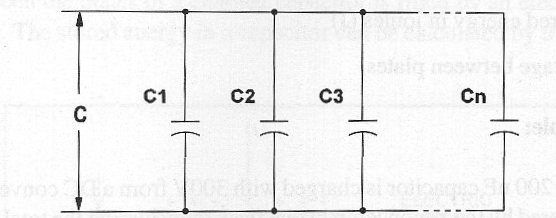The equivalent capacitance is the sum of the associated capacitances as follows:

--Formula 1
C = C1 + C2 + C3 + ..... + Cn
Where:
C is the equivalent capacitance in farads (F) or any submultiple
C1, C2, C3... Cn are parallel associated capacitors in farads (F) or any submultiple
Derivated Formulas
Formula 2
If n capacitors having the same capacitance (C1) are associated in parallel the equivalent capacitance C is calculated by the following “reduced” formula (C1 = C2 = C3 =.... = Cn):
C = n x C1
Where:
n is the number of associated capacitors
C is the equivalent capacitance (in the same unit of C1)
C1 is the value of one of the capacitors in the association
All in the same unit
Important Properties:
The equivalent capacitance is larger than the largest associated capacitor
All the capacitors are submitted to the same voltage
The largest capacitor stores the largest charge.
Application Example:
Calculate equivalent capacitance when wiring parallel capacitors of 20 µF, 30 µF and 50 µF
Data:
C1 = 20 µF
C2 = 30 µF
C3 = 50 µF
Apllying Formula1:
C = 20 + 30 + 50 = 100 µF




